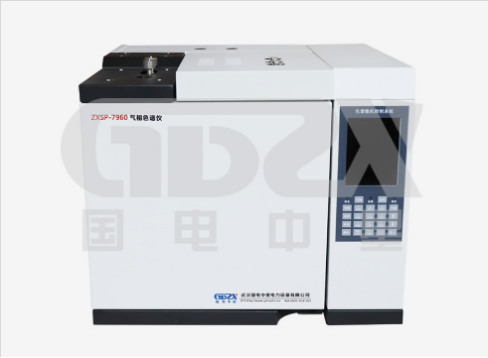NEWSnews
How to improve the sensitivity of an oil chromatography analyzer?
The oil chromatographic analyzer mainly uses the difference of boiling point, polarity and adsorption properties of substances to achieve the separation of mixtures. After the sample to be analyzed is vaporized in the gasification chamber, an inert gas (i.e. carrier gas, also known as mobile phase) is brought into the column. The column contains a liquid or solid stationary phase. The components of the sample tend to be in the mobile phase and form a distribution or adsorption equilibrium between the stationary phases.

As the carrier gas flows, the sample components are repeatedly distributed or adsorbed/desorbed during movement. The components with large concentration in the carrier gas first flow out of the chromatographic column, and the components with large concentration are distributed in the fixed phase. After the outflow. After the components flow out of the column, they enter the detector for determination.
How to improve the sensitivity of gas chromatography without increasing the sample concentration?
"Sensitivity" refers to the size of the electrical signal (voltage: mV, current: mA) generated when a certain amount of components pass through the detector.
Improving instrument sensitivity is an eternal topic in analytical chemistry. In the case of oil chromatography analyzers, instrument manufacturers and analysts are always trying to make instruments with high sensitivity and develop methods with high sensitivity. It is this demand that promotes the development of instruments, and the development of instruments makes regulatory manufacturers put forward higher detection sensitivity requirements. The interaction is cyclical. So how do you increase the sensitivity without increasing the sample concentration?
Reason analysis:
Reasons for reduced sensitivity may include:
1. Shunt injection is adopted.
2, the sample is not completely into the column.
3, the instrument is contaminated, especially the injection port and column, resulting in increased system noise, masking the response of the compound.
4. The compound is easily adsorbed by the active site at the inlet and has matrix effect.
5, the sensitivity of the selected detector is reduced.
Solution:
There are several ways to improve detection sensitivity:
① No shunt sampling: The so-called no shunt sampling means that the solenoid valve of the shunt gas path is closed during the sampling, so that all samples are injected into the column. This can increase sensitivity and eliminate transfer discrimination. The sensitivity of non-shunt injection is significantly higher than that of shunt injection, but the background signal is also increased. It is commonly used in environmental analysis (such as monitoring of trace pollutants in water and atmosphere), pesticide residue detection in food, and clinical and pharmaceutical analysis.
② Select a detector with high specificity and high sensitivity: this is also a common method for chromatographers to improve sensitivity. For example, ECD is used to analyze halogen-containing compounds, NPD is used to analyze nitrogen and phosphorus compounds, and FPD is used to analyze sulfur and phosphorus compounds. Of course, a more sensitive universal detector such as a mass spectrometry detector (MSD) can also be used.
③ Maintenance of instruments to reduce system noise: instrument system noise usually comes from two aspects: first, the instrument itself, such as detector noise, circuit noise, fixed phase loss, etc. The other is the sample matrix, such as the sample solution contains a lot of impurities, picking up high background noise may cause contamination of the sample port and column system. The former can be inhibited by the use of selective detectors and low-loss columns; The latter requires sample purification, such as solid phase extraction (SPE) or other methods to eliminate sample matrix interference, and timely replacement of liners, cleaning systems, etc.
④ The use of deactivated liner at the injection port: the active site on the liner may adsorb the component to be tested, resulting in a chromatogenic peak tailing, reducing sensitivity and affecting reproducibility. Using a deactivating liner with high inertivity, low loss, and good thermal stability can often significantly improve the sensitivity of the active substance when sampling or analyzing weakly polar compounds without diverting them, which was difficult to solve in previous analyses. Suitable for the analysis of complex substrates and active substances.
⑤ The use of pollution-free, low fixative loss of the chromatographic column: the use of the chromatographic column for a long time, the fixative loss is serious, resulting in the exposure of the carrier adsorption sample. Part of the carrier will become more and more, due to the existence of its active site, the analyzed component will directly contact the carrier surface during the analysis process to produce adsorption. At the same time, the loss of stationary phase increases the chromatographic baseline, which reduces sensitivity.
⑥ Use a matrix to formulate a standard solution to improve sensitivity: in GC analysis, matrix effects are often encountered, which seriously affect the accuracy and precision of the results. For example, organophosphorus pesticides with lower molecular weight are more susceptible to matrix and show matrix enhancement. Due to the presence of matrix, the active sites on the injector liner and column are covered, reducing the active sites and substances to be measured. The chance of contact enhances the signal of the substance to be measured. Therefore, as far as possible, a matrix extract of the same composition as the sample solution should be used as the diluent of the compound to improve the sensitivity of the compound under test.
GDZX is a professional manufacturer of secondary protection testing equipment, with a wide range of instruments and equipment to choose from. GDZX is at your service: 4000-828-027, for more information visit GDZX official website:www.gdzxdl.com。





















